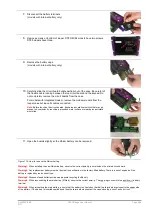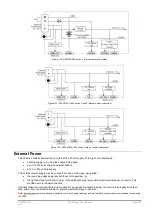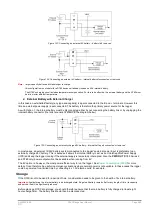
UM-0085-B09
DT80 Range User Manual
Page 292
RG
Monitoring DT80 Power
The
DT80
provides a number of internal channel types for monitoring the various power systems. These can be queried
at any time or used in alarms, like any other channel type.
The following channel types are available:
Channel Type Units
Description
VEXT
V
External power supply voltage
VBAT
V
Main battery terminal voltage (5.6V or lower indicates that internal battery is flat)
IBAT
mA
Instantaneous main battery current – positive if charging, negative if discharging
VLITH
V
Memory-backup battery voltage
Power Consumption
The
DT80
incorporates a number of power management features which aim to minimise the overall power consumption.
This section discusses how to estimate the average power consumption of the
DT80
in a given application, and gives
some guidelines on how to configure the
DT80
for minimum power usage.
Power Consumption
Power States
At any point in time the
DT80
is in one of three power states:
•
Active
– the
DT80
's microprocessor is running at full speed, actively performing a computation. Power usage is
highest when in this state.
•
Idle
– processor is idle; running at reduced speed and waiting for something to happen. The
DT80
automatically
and instantly switches between idle and active mode as required. Power usage is reduced by about 70% in this
state.
•
Sleep
– processor and most other hardware is powered down. The
DT80
will automatically "wake up" when
), a process which typically takes about 800 ms. Power usage is
lowest in this state – as low as 2mW when running from the internal battery.
Power Source
The
DT80
uses the least amount of power when it is running from the internal battery.
When external power is connected, there will be some losses in the
DT80
's internal power supply and battery charger, so
the overall power consumption will be higher. These losses will increase as the external voltage increases.
The following table gives an indication of how the typical instantaneous power consumption varies according to the
power source (internal/external) and supply voltage:
Power state
DT80
Battery power (6V)
DT80
External power
(12V)
DT80
External power
(24V)
DT82E/ 80L/ 85L
External Power
(12V)
DT82E/ 80L/ 85L
External Power
(24V)
Active
1200 mW
1800 mW
2200 mW
1300 mW
1400 mW
Idle
300 mW
500 mW
700 mW
350 mW
400 mW
Sleep
2 mW
60 mW
250 mW
10 mW
20 mW
Table 10: DT80 and DT82E/80L/85L core hardware instantaneous power consumption
Tthe power consumption for the low power models (those with 'E' or 'L' in the model name) is significantly less. This is
partly due to the fact that these models do not have an internal battery charger, which will consume some power even if
no battery is connected.
Note:
the power consumption values listed above are for the core hardware only, and do not include power used by other hardware
modules (within the
DT80
) which may or may not be enabled, depending on the application. These modules are described in the
following section.
Hardware Modules
The following hardware modules will consume additional power whilst they are enabled:
•
analog measurement subsystem
•
Ethernet Interface
•
integrated modem
(DT8xM only)
•
LCD backlight
•
battery charger
(DT80/ 82I/ 85/ 85G only)
















































